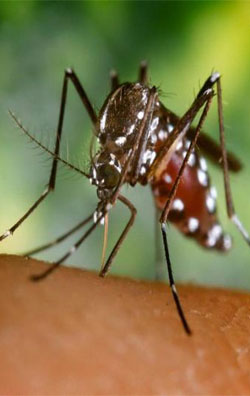
The Chikungunya is a viral disease caused by a single stranded RNA virus. It is denoted as CHIKV. This viral disease is spread to humans by the bite of Aedes aegypti and Aedes albopictus mosquitoes. The most denotable characteristic of this disease is the prolonged persistence of joint pains, even lasting for years in certain cases. Chikungunya predominantly occurs during rainy weather conditions. Breeding usually takes place in clean water.
It takes about 1-12 days for the disease to be commenced once the virus enters the body. Common symptoms include very high fever, even up to 40 0 C, rashes on the chest and legs, headache, vomiting, partial loss of taste, etc. Swelling of the legs is visualized among some people. Swollen and painful joints on touch are also seen. In newborns, it can cause meningoencephalitis; swelling of the brain. The disease, even spreads from a pregnant woman to the fetus.
Recovery usually takes place within 3-5 days and it depends upon the age of the patient. The elderly patients take more time to recover. Pain in the joints, swelling and difficulty in movement, feeling of stiffness especially in the morning, etc. seem to persist even after months of recovery.
Studies regarding the recurrence of the disease show that, the virus has the ability to establish persistent infections. After 16 weeks of inoculation in a mouse model, the viral RNA was detected specifically from tissues associated with joints.
To avoid biteing of the mosquitoes are the only means of prevention. By wearing full sleeve clothes that cover the legs and hands provide protection from mosquitoes biting during day time. Pyrethroids, a class of insecticides are commonly used to repel insects. By protecting doors and windows with screens also help to keep the mosquitoes away. Even coils used as mosquito repellents contain vaporized Pyrethroids. Other insect repellents commonly used include; DEET, icaridin/ picaridin, PMD, etc.
Water stagnant areas which act as breeding centers have to be identified and disinfected. The larvae of the mosquitoes should be killed using insecticides. The infected person should keep away from mosquito bite to prevent it from being spread to others. Pots, buckets, dishes, etc. should be emptied to prevent the water from being remaining stagnant in them. Small children should be made to sleep only under nets. Containers of water kept for domestic purpose should be well closed to prevent the mosquitoes from laying eggs. In decorative ponds; fishes that feed on larvae should be grown. Maintaining of clean surroundings, removing of unwanted plants such as weeds, maintaining proper sanitation and hygiene will help keep away mosquitoes to a great extend.
Detection of Chikungunya in laboratories is done by isolation of virus, RT-PCR and serological testing.
1. Virus isolation is done by exposing specific cell lines to sample of blood to be tested and check for the presence of Chikungunya specific responses.
2. RT-PCR is method of Chikungunya specific gene amplification from the tested blood sample.
3. Serological test includes ELISA technique to quantify the IgM and IgG levels specific to chikungunya.
Approved vaccines are not presently available. Ribavirin, acetaminophen, etc. are given for symptoms like joint pain. Fluids are also advised to improve health. Effective homeopathic treatments are advised for Chikungunya.





